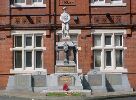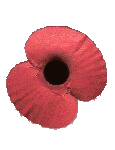
Newton-le-Willows and
Earlestown War Memorial

| OTHER WARS |
 |
Newton-le-Willows andEarlestown War Memorial |
 |
| The
Great War Roll of Honour |
|||||||||||||||||||||||||

Daniel was the husband of Ellen O’Donnell of 36, Athol Street, Earlestown. CWGC, who prepared their records after the war, gives her name as Ellen Halsted but of the same address. It is possible that she reverted to her maiden name, or re-married. They had four children.
A very brief obituary was published in the NEG on May 14th 1916 which gave few personal details.
Daniel is buried in Kemmel Chateau Military Cemetery, Heuvelland, which is eight kilometres south of Ieper, in Grave A 26. The cemetery was badly shelled during fighting in Spring 1918 and the old chateau was destroyed. There are now 1,135 Commonwealth burials of the First World War in the cemetery.
The Battalion Diary gives an indication of life for the 2nd Battalion on the
day Daniel was killed:
“January 29th Fri. Fine. Clear and frosty. General disposition of Battalion
unchanged. “A” and “C” Companies moved forward to fire
trenches. “B” and “D” withdrew to supports.
“Between 2.30 and 3 pm. enemy’s aeroplane was noticed above fire
trenches and support line. Shortly afterwards the village of KEMMEL was heavily
shelled at the Eastern end. Eight heavy shelled (sic) pitched in vicinity of
houses in which companies in support – A and C were accommodated. The
Companies turned out but were caught by shells as they vacated the buildings,
4 men being killed and 18 wounded.
“During the evening “B” and “D” Companies moved
forward to fire trenches in relief of “A” and “C” who
withdrew to supports. The relief was rendered difficult by the bright moonlight
2 men being wounded. One man who was carrying supplies to the position “G.2”
was also wounded by a sniper.
“A corner of the road between F 8 and F 7 and 500 yards West of G.1 was
much marked.
“Colonel F.A.Dudgeon, Commanding 1st Battalion, arrived from being A.A.G.
3rd Echelon, G.H.Q. to take command of 2nd Battalion from Major Sweney R.Fus.”
Whalley-Kelly describes life for the Battalion during the first two months
of 1915:
“In January Lieutenant-Colonel F. A. Dudgeon, lately commanding the 1st
Battalion in India, relinquished a Staff appointment with the Indian Corps to
take command of the 2nd Battalion, and other Regular officers such as Major
H. T. Cotton, Captain W. V. Hume and Captain F. W. M. Drew rejoined from various
similar appointments. When out of the line no opportunity was lost of training,
close-order drill figuring largely in the programme, while strict attention
was paid to personal smartness and turn-out as soon as a tour in the trenches
had finished, and the clinging mud could be scraped off uniforms and equipment.
“During the first few months of 1915 the trenches occupied were situated
on the lower slopes of the Messines Ridge in the neighbourhood, at different
periods, of Lindenhoek, Kemmel, Spanbrockmolen, Wytschaete. and St. Eloi, names
that will live for ever in the memory of those who fought for England in 1914-1918.
The word "trenches" is used, but it is a misnomer, conveying quite
a wrong impression of the actual facts. In the inferno of the First Ypres both
sides had fought to a standstill and the British troops had "dug in"
wherever they happened to be when the last embers of the battle were flickering
and dying out, and this was not always the best position for a prolonged defence
or sojourn, either tactically or topographically. Consequently the front line
consisted mainly of disconnected lengths of muddy field works, partly trench,
partly breastwork, with few traverses and little shelter from the elements or
the enemy's shells. Duckboards, communication trenches, deep dug-outs and other
refinements of later days were non-existent, and the exposed position of many
of the localities made improvement a matter of great danger and difficulty.
It was about this time that a special issue of head-ropes was made for the purpose
of pulling out men who were stuck in the mud.
“At this period the normal tour for companies in the front line was twenty-four
hours, during which a hot meal was a rare luxury, and there was no possibility
of drying clothes, sodden with mud and water, after a journey, crouching and
crawling, across the open to carry out the relief. The dead of both sides had
been built into the parapets and parados, and it was no uncommon thing to find
an arm or leg projecting from the revetment; while in one isolated trench, held
by the 2nd Battalion at various times, it is no exaggeration that the platoon
officer's command post consisted of sandbags supported by a dead Frenchman covered
with a few inches of earth. With this grisly seat the occupant had to be content,
and counted himself lucky to be raised above the mud, while his feet rested
on something hidden in the slime-a "something" which was later discovered
to be the rotting corpse of a Prussian grenadier.
“We must now pass on. Abler pens have described in vivid language the
hardships endured without flinching by the British Army during that first terrible
winter in France and Flanders, and space does not permit of a narrative in detail
of the many vicissitudes of this period: the long night marches along the pave,
and over the open water-logged fields, heavily laden, to relieve another unit
in the front line; the all-too-brief periods of rest, broken by wiring and digging
operations with their inevitable toll of casualties; the days and nights in
muddy ditches, dignified by the name of trenches, sniped and shelled constantly
by an enterprising and aggressive enemy; the humour and pathos and, above all,
the stoical endurance of the regimental officer and his men who, without exception,
maintained unimpaired their customary disregard of danger and privation, and
their will to fight.
“No active operations were undertaken during January and February, but
let it not be thought that no aggressive action was taken during tours in the
trenches; sniping and patrolling were constant, and the artillery, limited as
their ammunition supply was at this time, lost no opportunity of helping the
infantry to harass the Boche. These tactics called forth retaliation, and few
days passed without some officers and men being killed or wounded.
“In February the 4th Battalion, fresh from England, was attached to the
7th Infantry Brigade for instruction and thus was perpetuated, under the common
stress of war, the close liaison between the Regular and Territorial Battalions
of the Regiment that had its beginnings in South Africa fifteen years before.”